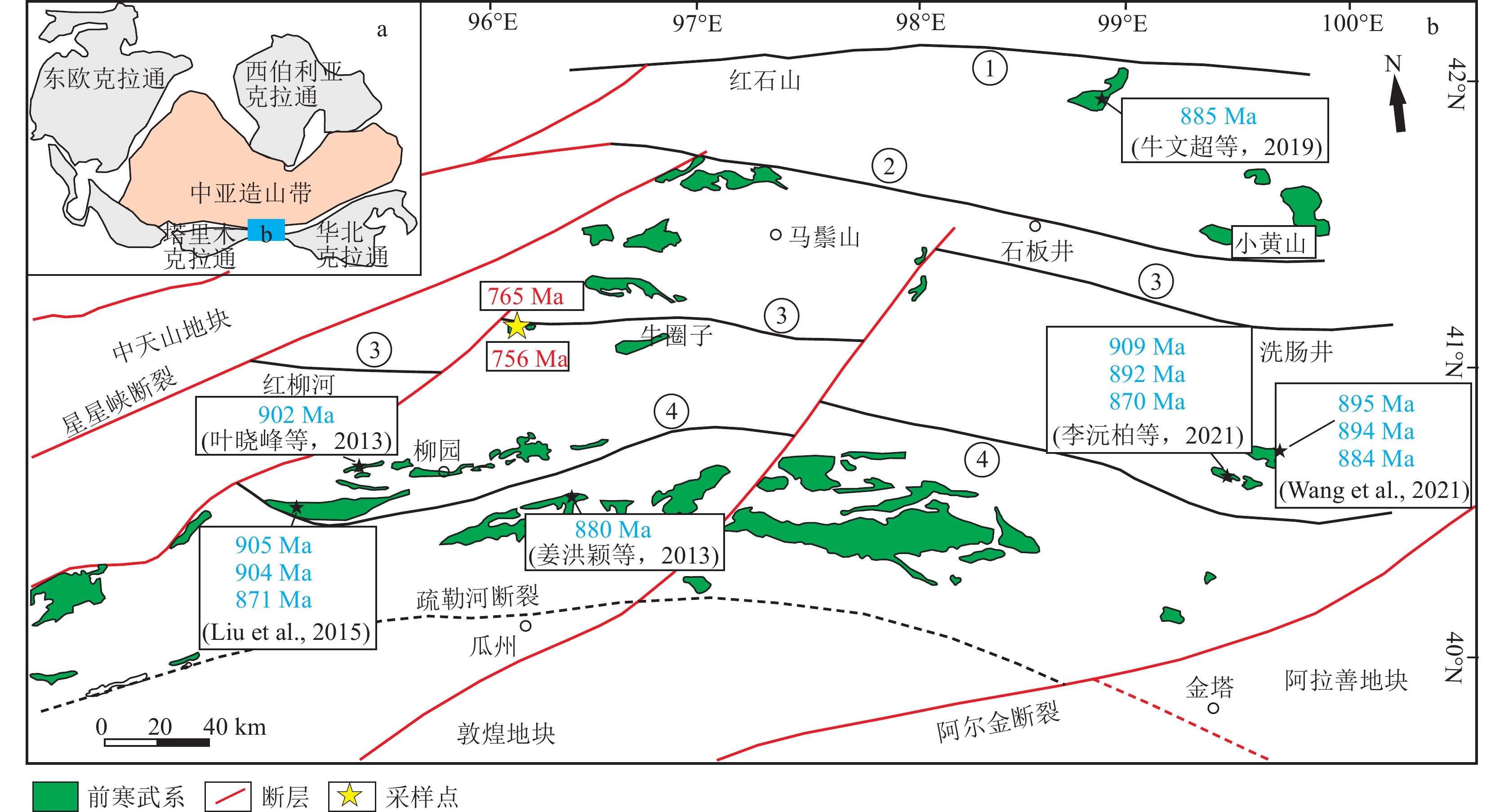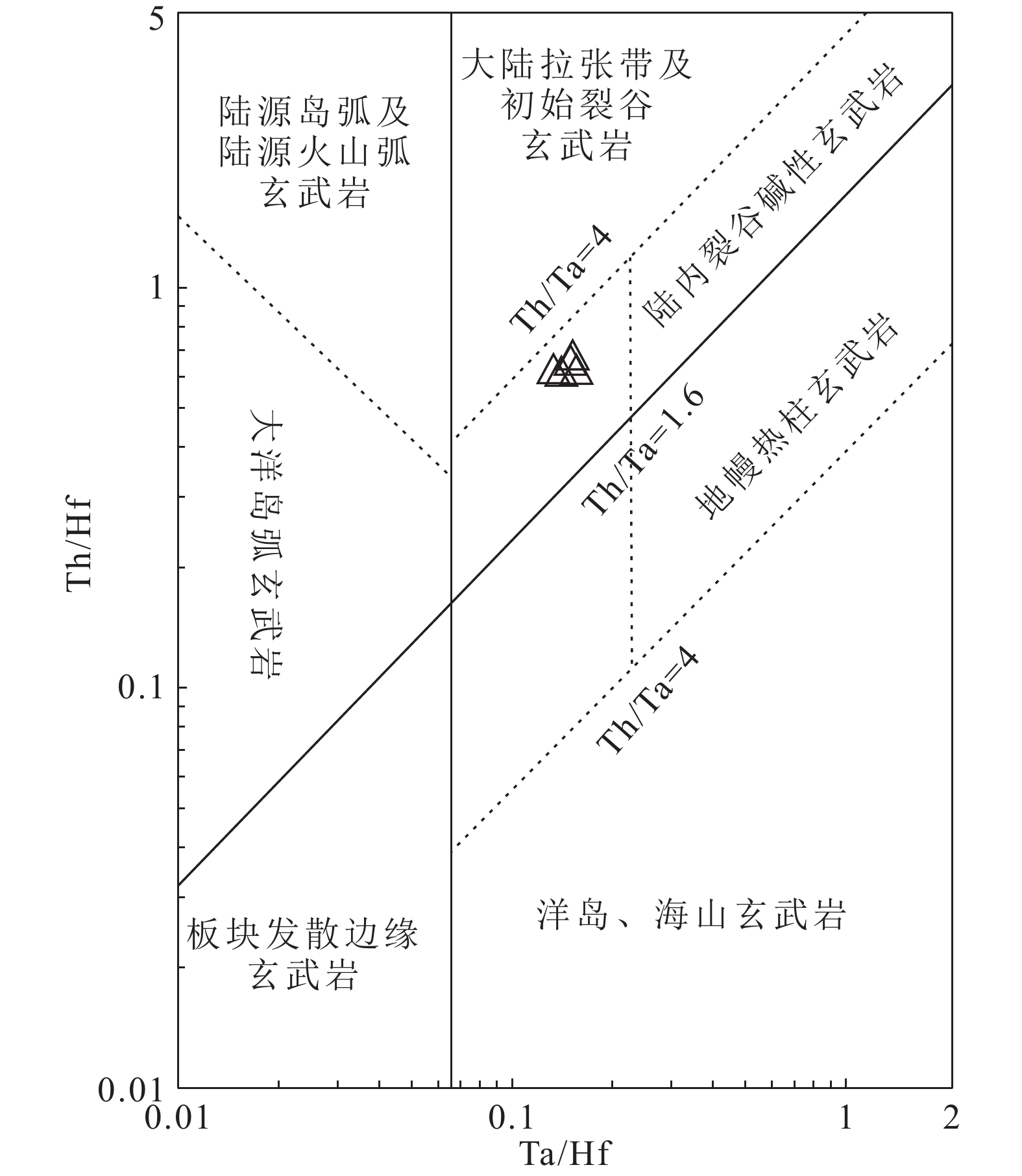Neoproterozoic magmatic rocks associated with the opening of Paleo-Asian Ocean in Beishan area
-
摘要:
研究目的 中亚造山带南缘北山地区分布的前寒武系岩石对研究古亚洲洋的形成演化及成矿具有重要的价值,但北山地区与古亚洲洋打开相关的岩浆证据发现极少,北山红山铁矿的形成时代也缺少精确的同位素年代学约束。
研究方法 基于此,在野外调查的基础上,对研究区新发现的新元古代岩浆岩开展了锆石U−Pb年代学和地球化学研究。
研究结果 北山地区中部独红山辉长岩和与红山铁矿相关的安山质凝灰岩年龄分别为765 Ma 和756 Ma,且辉长岩地球化学特征具有板内(大陆)裂谷构造背景。
结论 结合已有研究和区域构造演化,认为古亚洲洋南段在北山地区打开的时限不早于765 Ma,北山红山铁矿形成于南华纪(756 Ma)。
Abstract:Objective Precambrian rocks distributed in the Beishan area, located in the southern Central Asian Orogenic Belt, is significant for the study of the formation of the Paleo−Asian Ocean (PAO) and its associated mineralization. However, there are no constraints on the magmatism related to opening of PAO, and there is a lack of accurate chronological data regarding the formation of the Hongshan Iron Ore (HIO) deposits in the Beishan area.
Methods We present the results of field investigations, zircon U−Pb dating, and geochemical analyses of the gabbro and andesitic tuff found in the central Beishan area.
Results The new U−Pb dating results reveal the crystallization ages of the gabbro and andesitic tuff crystallized at 765 Ma, 756 Ma, respectively. The geochemical composition of the gabbro is indicative of an intraplate rift setting, suggesting a continental tectonic environment during its formation.
Conclusions Integrating our findings with previous studies, we infer that the southern PAO had opened before 765 Ma in the Beishan area. Additionally, we conclude that the HIO formation occurred during the Nanhuanian Period (756 Ma).
-
Key words:
- Beishan area /
- opening time of Paleo-Asian Ocean /
- Neoproterozoic /
- magmatic rocks
-

-
图 1 北山地区大地构造位置图(a)和前寒武纪岩石分布地质简图 (b)(据Xiao et al., 2010修改)
Figure 1.
图 3 辉长岩球粒陨石标准化稀土元素配分图(a)和原始地幔标准化微量元素蛛网图(b)(标准数据据Sun et al., 1989)
Figure 3.
表 1 LA−ICP−MS辉长岩(22NH1)斜锆石和安山质凝灰岩(22NA1)锆石U−Th−Pb分析结果
Table 1. LA–ICP–MS baddeleyite and zircon U−Th−Pb dating results of gabbro (22NH1) and andesitic tuff (22NA1)
样品点 同位素比值 年龄/Ma Th/U 207Pb/235U 206Pb/238U 207Pb/235U 206Pb/238U 22NH1-1 1.117129 0.067129 0.121764 0.002376 760 33 741 14 22NH1-2 1.264123 0.119984 0.130855 0.006655 827 53 792 38 22NH1-3 1.121016 0.071244 0.118706 0.005253 761 35 723 30 22NH1-4 1.192607 0.104843 0.129957 0.007484 793 47 787 43 22NH1-5 1.159991 0.108900 0.128444 0.005101 776 52 779 29 22NH1-6 1.196924 0.089732 0.126729 0.004735 795 41 769 27 22NH1-7 1.222216 0.085535 0.127834 0.005236 809 38 775 30 22NH1-8 1.183342 0.082417 0.126931 0.006272 791 38 770 36 22NH1-9 1.147928 0.043166 0.123183 0.004378 775 20 749 25 22NH1-10 1.171261 0.053922 0.127390 0.005529 787 26 773 32 22NH1-11 1.218945 0.062680 0.132010 0.004891 807 29 799 28 22NH1-12 1.158849 0.055603 0.129926 0.003349 779 26 787 19 22NH1-13 1.487374 0.108175 0.134216 0.006542 922 44 812 37 22NH1-14 1.079578 0.040262 0.123204 0.003824 743 20 749 22 22NH1-15 1.171701 0.043205 0.124850 0.005035 787 20 758 29 22NH1-16 1.403479 0.168475 0.128608 0.007667 886 69 780 44 22NH1-17 1.206492 0.090860 0.129735 0.006194 801 42 786 35 22NH1-18 1.148425 0.042905 0.124176 0.004229 776 20 755 24 22NH1-19 1.128534 0.073536 0.127147 0.003716 763 36 771 21 22NH1-20 1.188456 0.038565 0.122574 0.005935 795 18 745 34 22NH1-21 1.163731 0.080875 0.123863 0.004524 783 37 753 26 22NH1-22 1.191809 0.065867 0.122917 0.003866 796 31 747 22 22NH1-23 1.219003 0.063952 0.130849 0.004897 808 30 793 28 22NH1-24 1.190767 0.062231 0.130884 0.004749 796 29 793 27 22NH1-25 1.285008 0.098125 0.128891 0.012415 838 45 781 71 22NA1-1 1.10282 0.0302 0.12728 0.00288 772 16 755 15 1.61 22NA1-2 1.09354 0.03944 0.11706 0.00287 714 17 750 19 2.22 22NA1-3 1.16855 0.03693 0.12875 0.00344 781 20 786 17 1.14 22NA1-4 1.10348 0.04122 0.12922 0.00357 783 20 755 20 1.32 22NA1-5 1.12034 0.04114 0.11879 0.00337 724 19 763 20 2.44 22NA1-6 1.08198 0.05187 0.11896 0.00381 725 22 745 25 2.70 22NA1-7 1.14455 0.04978 0.12886 0.00437 781 25 775 24 1.69 22NA1-8 1.74539 0.08037 0.17203 0.00603 1023 33 1025 30 2.00 22NA1-9 1.21976 0.07509 0.13254 0.00563 802 32 810 34 2.44 22NA1-10 1.12936 0.08245 0.12381 0.00552 752 32 767 39 6.25 22NA1-11 1.85548 0.1267 0.16654 0.0077 993 43 1065 45 2.50 22NA1-12 1.16807 0.08771 0.13138 0.00637 796 36 786 41 1.92 22NA1-13 3.05115 0.29745 0.24721 0.01398 1424 72 1421 75 1.35 22NA1-14 4.55978 0.51783 0.31674 0.01904 1774 93 1742 95 1.43 22NA1-15 4.43174 0.54698 0.30534 0.01944 1718 96 1718 102 1.89 22NA1-16 5.58515 0.78992 0.34394 0.02334 1906 112 1914 122 1.61 -
[1] Bu T, Wang G Q, Huang B T, et al. 2022. Neoproterozoic A−type granites in northern Beishan Orogenic Belt: Early response of the Rodinia supercontinent break−up[J]. Acta Petrologica Sinica, 38(10): 2988−3002 (in Chinese with English abstract).
[2] Cleven N, Lin S, Guilmette C, et al. 2015. Petrogenesis and implications for tectonic setting of Cambrian suprasubduction−zone ophiolitic rocks in the central Beishan orogenic collage, Northwest China[J]. Journal of Asian Earth Sciences, 113: 369−390.
[3] He Z Y, Klemd L, Zhang M, et al. 2018. The origin and crustal evolution of microcontinents in the Beishan orogen of the southern Central Asian Orogenic Belt[J]. Earth−Science Reviews, 185: 1−14.
[4] Huang B, Wang X, Li T, et al. 2022. Precambrian tectonic affinity of the Beishan Orogenic Belt: Constraints from Proterozoic metasedimentary rocks[J]. Precambrian Research, 376: 106686.
[5] Jiang H Y, He Z Y, Zong K Q, et al. 2013. Zircon U−Pb dating and Hf isotopic studies on the Beishan complex in the southern Beishan orogenic belt[J]. Acta Petrologica Sinica, 29(11): 3949−3967 (in Chinese with English abstract).
[6] Li Y B, Li H Q, Zhou W X, et al. 2021. Neoproterozoic thermal events and tectonic implications in the Beishan orogenic belt: Geochemical and geochronological evidence from two sets of granitic rocks from southern Beishan orogenic belt, Gansu Province[J]. Geological Bulletin of China, 40(7): 1117−1139 (in Chinese with English abstract).
[7] Li Z X, Bogdanova S V, Collins A S, et al. 2008. Assembly, configuration, and break−up history of Rodinia: A synthesis[J]. Precambrian Research, 160(1/2): 179−210.
[8] Liu Q, Zhao G, Sun M, et al. 2015. Ages and tectonic implications of Neoproterozoic ortho− and parageneses in the Beishan Orogenic Belt, China[J]. Precambrian Research, 266: 551−578.
[9] Niu W C, Ren B F, Ren Y W, et al. 2019. Neoproterozoic Magmatic Records in the North Beishan Orogenic Belt: Evidence of the Gneissic Granites from the Hazhu area, Inner Mongolia[J]. Earth Science, 44(1): 284−297 (in Chinese with English abstract).
[10] Su B X, Qin K Z, Sakyi P A, et al. 2011. Geochemistry and geochronology of acidic rocks in the Beishan region, NW China: Petrogenesis and tectonic implications[J]. Journal of Asian Earth Sciences, 41: 31−43.
[11] Sun S S, McDonough W F. 1989. Chemical and isotopic systematics of oceanic basalts: Implications for mantle composition and processes[J]. Geological Society, London, Special Publications, 42(1): 313−345.
[12] Wan B, Li S, Xiao W, et al. 2018. Where and when did the Paleo−Asian Ocean form?[J]. Precambrian Research. 317: 241−252.
[13] Wang B, Yang X, Li S, et al. 2021. Geochronology, geochemistry, and tectonic implications of early Neoproterozoic granitic rocks from the eastern Beishan Orogenic Belt, southern Central Asian Orogenic Belt[J]. Precambrian Research, 352: 106016.
[14] Xiao W J, Mao Q G, Windley B F, et al. 2010. Paleozoic multiple accretionary and collisional processes of the Beishan orogenic collage[J]. American Journal of Science, 310(10): 1553−1594.
[15] Xu B, Jian P, Zheng H, et al. 2005. U–Pb zircon geochronology and geochemistry of Neoproterozoic volcanic rocks in the Tarim Block of northwest China: Implications for the breakup of Rodinia supercontinent and Neoproterozoic glaciation[J]. Precambrian Research, 136: 107−123.
[16] Xu Z Q, Liu L L, Qi X X, et al. 2006. Record for Rodinia supercontinent breakup event in the south Sulu ultra−high pressure metamorphic terrane[J]. Acta Petrologica Sinica, 22(7): 1745−1760 (in Chinese with English abstract).
[17] Yang X, Xu X H, Li H L, et al. 2017. Early Neoproterozoic tectonie framework of north margin of Tarim Basin, constraints from zircon U−Pb geochronology and geochemistry[J]. Geotectonica et Metallogenia, 41(2): 381−395 (in Chinese with English abstract).
[18] Ye X X, Zong K Q, Zhang Z M, et al. 2013. Geochemistry of Neoproterozoic granite in Liuyuan area of southern Beishan orogenic belt and its geological significance[J]. Geological Bulletin of China, 32(2/3): 307−317 (in Chinese with English abstract).
[19] Yu J Y, Li X M, Liang J W, et al. 2012. Evolution of the geological structure in Beishan area across Gansu Province, Xinjiang Autonomous Region and Inner Mongolia Autonomous Region: Constraints on the timing of opening and closing of the Beishan Paleozoic Oceanic Basin[J]. Xinjiang Geology, 30(2): 205−209 (in Chinese with English abstract).
[20] Zheng R, Li J, Xiao W, et al. 2022. A combination of plume and subduction tectonics contributing to breakup of northern Rodinia: Constraints from the Neoproterozoic magmatism in the Dunhuang–Alxa Block, northwest China[J]. GSA Bulletin, 135(5/6): 1109−1126.
[21] Zheng R, Li J, Zhang J, et al. 2020. Permian oceanic slab subduction in the southmost of Central Asian Orogenic Belt: Evidence from adakite and high−Mg diorite in the southern Beishan[J]. Lithos, 358/359: 105406.
[22] Zhu Q, Zheng Z X, Li T B, et al. 2018. Response of the North China Craton to the Rodinia supercontinent breakup: New evidence from petrochemistry, chronology and Hf isotope of the gabbro in Xiaosongshan area of northern Helan Mountain[J]. Geological Bulletin of China, 37(6): 1075−1086 (in Chinese with English abstract).
[23] Zuo G C, Liu Y K, Li S X. 2010. Metallogenesis and mechanism of Hongshan Iron deposit in Beishan region of Gansu Province[J]. Gansu Geology, 19(3): 9−18 (in Chinese with English abstract).
[24] 卜涛, 王国强, 黄博涛, 等. 2022. 北山北带新元古代 A 型花岗岩: Rodinia超大陆裂解早期的地质响应[J]. 岩石学报, 38(10): 2988−3002.
[25] 姜洪颖, 贺振宇, 宗克清, 等. 2013. 北山造山带南缘北山杂岩的锆石U−Pb定年和Hf同位素研究[J]. 岩石学报, 29(11): 3949−3967.
[26] 李沅柏, 李海泉, 周文孝, 等. 2021. 北山造山带新元古代热事件及其构造意义: 来自甘肃北山南带两期花岗质岩的地球化学和年代学证据[J]. 地质通报, 40(7): 1117−1139.
[27] 牛文超, 任邦方, 任云伟, 等. 2019. 北山北带新元古代岩浆记录: 来自内蒙古哈珠地区片麻状花岗岩的证据[J]. 地球科学, 44(1): 284−297.
[28] 许志琴, 刘福来, 戚学祥, 等. 2006. 南苏鲁超高压变质地体中罗迪尼亚超大陆裂解事件的记录[J]. 岩石学报, (7): 1745−1760.
[29] 杨鑫, 徐旭辉, 李慧莉, 等. 2017. 塔里木北缘新元古代早期构造演化的锆石U−Pb年代学和地球化学约束[J]. 大地构造与成矿学, 41(2): 381−395.
[30] 叶晓峰, 宗克清, 张泽明, 等. 2013. 北山造山带南缘柳园地区新元古代花岗岩的地球化学特征及其地质意义[J]. 地质通报, 32(2/3): 307−317.
[31] 余吉远, 李向民, 梁积伟, 等. 2012. 甘新蒙北山地区古生代构造演化研究——北山古生代洋盆开启、闭合时限最新进展[J]. 新疆地质, 30(2): 205−209.
[32] 朱强, 曾佐勋, 李天斌, 等. 2018. 华北克拉通对Rodinia超大陆裂解的响应——来自贺兰山北段小松山地区辉长岩地球化学、年代学及Hf同位素的新证据[J]. 地质通报, 37(6): 1075−1086.
[33] 左国朝, 刘义科, 李绍雄. 2010. 甘肃北山地区红山铁矿床成因及成矿机制[J]. 甘肃地质, 19(3): 9−18.
-




 下载:
下载:



